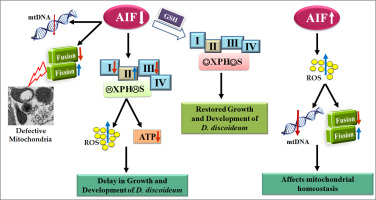当前位置:
X-MOL 学术
›
BBA Bioenerg.
›
论文详情
Our official English website, www.x-mol.net, welcomes your
feedback! (Note: you will need to create a separate account there.)
Apoptosis inducing factor: Cellular protective function in Dictyostelium discoideum.
Biochimica et Biophysica Acta (BBA) - Bioenergetics ( IF 3.4 ) Pub Date : 2020-01-25 , DOI: 10.1016/j.bbabio.2020.148158 Ashlesha Kadam 1 , Darshan Mehta 1 , Tina Jubin 1 , Mohmmad Shoab Mansuri 1 , Rasheedunnisa Begum 1
Biochimica et Biophysica Acta (BBA) - Bioenergetics ( IF 3.4 ) Pub Date : 2020-01-25 , DOI: 10.1016/j.bbabio.2020.148158 Ashlesha Kadam 1 , Darshan Mehta 1 , Tina Jubin 1 , Mohmmad Shoab Mansuri 1 , Rasheedunnisa Begum 1
Affiliation

|
Apoptosis Inducing Factor (AIF), a nuclear encoded mitochondrial inter-membrane space flavoprotein with intrinsic NADH oxidase activity, plays an important role in inducing cell death mechanisms. In response to cell death signals, it undergoes mitochondrio-nuclear translocation leading to DNA fragmentation. In addition to its role in cell death, AIF has a pro-survival role, wherein it contributes to the maintenance of mitochondrial structure and function in a coordinated manner. However, its exact mechanism of controlling mitochondrial homeostasis is unclear. The current study aims to explore the protective functions of AIF by its downregulation and overexpression in Dictyostelium discoideum. Constitutive AIF downregulated (dR) cells exhibited compromised oxidative phosphorylation along with elevated levels of cellular ROS. Interestingly, constitutive AIF dR cells showed amelioration in the activity of the ETC complexes upon antioxidant treatment, strengthening AIF's role as an ROS regulator, by virtue of its oxidoreductase property. Also, constitutive AIF dR cells showed lower transcript levels of the various subunits of ETC. Moreover, loss of AIF affected mtDNA content and mitochondrial fusion-fission mechanism, which subsequently caused morphometric mitochondrial alterations. Constitutive AIF overexpressed (OE) cells also showed higher cellular ROS and mitochondrial fission genes transcript levels along with reduced mitochondrial fusion genes transcript levels and mtDNA content. Thus, the results of the current study provide a paradigm where AIF is implicated in cell survival by maintaining mitochondrial bioenergetics, morphology and fusion-fission mechanism in D. discoideum, an evolutionarily significant model organism for mitochondrial diseases.
中文翻译:

凋亡诱导因子:盘基网柄菌的细胞保护功能。
凋亡诱导因子(AIF)是一种核编码的线粒体膜间空间黄素蛋白,具有固有的NADH氧化酶活性,在诱导细胞死亡机制中起重要作用。响应细胞死亡信号,它经历线粒体-核易位,导致DNA断裂。除在细胞死亡中的作用外,AIF还具有生存作用,其中它以协调的方式有助于维持线粒体的结构和功能。但是,其控制线粒体稳态的确切机制尚不清楚。当前的研究旨在通过下调和在盘基网柄菌中过表达来探讨AIF的保护功能。组成性AIF下调(dR)细胞表现出受损的氧化磷酸化以及细胞ROS水平升高。有趣的是 组成型AIF dR细胞经过抗氧化剂处理后,ETC络合物的活性得到改善,凭借其氧化还原酶特性增强了AIF作为ROS调节剂的作用。同样,组成型AIF dR细胞显示ETC各个亚基的转录水平较低。此外,AIF的损失影响线粒体DNA含量和线粒体融合分裂机制,继而引起形态学线粒体改变。组成性AIF过表达(OE)细胞还显示较高的细胞ROS和线粒体裂变基因转录水平,同时线粒体融合基因转录水平和mtDNA含量降低。因此,本研究的结果提供了一种范例,其中AIF通过维持D中的线粒体生物能,形态和融合裂变机制而牵涉细胞存活。
更新日期:2020-03-22
中文翻译:

凋亡诱导因子:盘基网柄菌的细胞保护功能。
凋亡诱导因子(AIF)是一种核编码的线粒体膜间空间黄素蛋白,具有固有的NADH氧化酶活性,在诱导细胞死亡机制中起重要作用。响应细胞死亡信号,它经历线粒体-核易位,导致DNA断裂。除在细胞死亡中的作用外,AIF还具有生存作用,其中它以协调的方式有助于维持线粒体的结构和功能。但是,其控制线粒体稳态的确切机制尚不清楚。当前的研究旨在通过下调和在盘基网柄菌中过表达来探讨AIF的保护功能。组成性AIF下调(dR)细胞表现出受损的氧化磷酸化以及细胞ROS水平升高。有趣的是 组成型AIF dR细胞经过抗氧化剂处理后,ETC络合物的活性得到改善,凭借其氧化还原酶特性增强了AIF作为ROS调节剂的作用。同样,组成型AIF dR细胞显示ETC各个亚基的转录水平较低。此外,AIF的损失影响线粒体DNA含量和线粒体融合分裂机制,继而引起形态学线粒体改变。组成性AIF过表达(OE)细胞还显示较高的细胞ROS和线粒体裂变基因转录水平,同时线粒体融合基因转录水平和mtDNA含量降低。因此,本研究的结果提供了一种范例,其中AIF通过维持D中的线粒体生物能,形态和融合裂变机制而牵涉细胞存活。











































 京公网安备 11010802027423号
京公网安备 11010802027423号